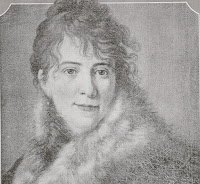Katherine Wilmot facts for kids
Quick facts for kids
Katherine Wilmot
|
|
|---|---|
 |
|
| Born | c. 1773 Drogheda, County Louth |
| Died | 28 March 1824 (aged 52–53) Paris, France |
| Occupation | Writer |
| Nationality | Irish |
| Period | 18th century |
Katherine Wilmot (born around 1773, died 1824) was an Irish writer. She was known for her travel journals and diaries. These writings give us a unique look into what life was like in the early 1800s. She traveled across Europe, meeting important people and seeing many different places.
Contents
Early Life and Family Travels
Katherine Wilmot was born in Drogheda, County Louth, Ireland, around 1773. Her parents were Edward and Martha Wilmot. She was the oldest of six daughters and three sons. Her father worked as a port surveyor, which meant he inspected ships and goods.
In 1775, her family moved to County Cork. They settled in a place called Glanmire. This was close to the home of the Earl of Mountcashell. The Earl's family, whose last name was Moore, became good friends with the Wilmots.
Grand Tour of Europe
Katherine became friends with Lady Mountcashell, whose maiden name was Margaret King. Lady Mountcashell had been a student of the famous writer Mary Wollstonecraft. In 1801, Katherine was invited to join the Earl and Lady Mountcashell on a "Grand Tour" of Europe. This was a long trip that wealthy young people often took to learn about art and culture.
Katherine wrote many letters during this trip. These letters tell us about her adventures in France from November 1801 to October 1802. She then traveled to Italy until July 1803.
Meeting Famous People
While in Paris, the Mountcashells hosted many fancy parties. Through them, Katherine met some very important people. She met Napoleon Bonaparte, who was a powerful leader in France. She also became friends with Angelica Kauffman, a famous Austrian painter.
Katherine also met Charles Maurice de Talleyrand-Périgord, a French diplomat. She briefly met Robert Emmet, an Irish rebel. In Rome, she met the English aristocrat Frederick Hervey, 4th Earl of Bristol. She even had a special meeting with Pius VII, who was the Pope at the time.
Katherine left Italy in October 1803. She traveled through Germany and Denmark to get back to London. This was because England and France had started fighting again.
Journey to Russia
After her European tour, Katherine went to Russia. Her sister, Martha Wilmot, was living there. Martha was a close friend of Princess Dashkov. The Princess was a very important figure in the Russian Enlightenment. She was also a good friend of Catherine the Great, the empress of Russia.
Martha lived at the Princess's estate in Troitskoe. This was about 100 kilometers from Moscow. Katherine arrived in Russia on August 4, 1805. She had started her journey from Cork, Ireland, on June 5.
Life in Russia
Katherine's writings from Russia describe the rich lifestyle of the Russian nobility. She also wrote about how the wealthy treated the poor working people, known as serfs. The sisters learned a lot about Russian customs. They saw the festivals and religious traditions of the country people.
Katherine left Moscow on July 4, 1807. Her journey home was delayed by problems with her passport, wars, and bad storms at sea. She finally reached Yarmouth, England, on September 7, 1807. She returned to Ireland in October 1807.
Later Years and Death
Later in her life, Katherine moved to Moulins, France. She hoped that a warmer, drier climate would be better for her health. However, her health got worse when she moved to Paris. She passed away there on March 28, 1824. Her nephew, Wilmot Henry Bradford, became a respected military figure.
Published Works
Katherine Wilmot's writings give us a special look into history.
Princess Dashkov's Memoirs
When Katherine left Russia, she took a copy of Princess Dashkov's memoirs. These were the Princess's life stories. Martha Wilmot later published these memoirs in 1840. The original manuscript had been burned by Martha before she left Russia in 1808.
Katherine's Letters and Diaries
Katherine Wilmot's own letters were published much later. They are seen as a unique description of the time when Napoleon was powerful. They tell us about social life back then. They also describe what it was like to travel by coach and ship.
Katherine's family made copies of her letters. The collection that belonged to Martha was given to the library of the Royal Irish Academy. Among these Russian letters are some written by Eleanor Cavanagh. These letters describe the lives of servants.
Katherine Wilmot's diaries were published in 1920 by Thomas Sadleir. They were also published later by H. Montgomery Hyde and the Marchioness of Londonderry.
- An Irish Peer on the Continent, 1801-03 (1920)
- The Russian Journals of Martha and Catherine Wilmot (1934)
- More letters from Martha Wilmot; Vienna 1819-29 (1935)
- The Grand Tours of Katherine Wilmot, France 1801-1803, and Russia 1805-07 (Weidenfeld & Nicolson, 1992)

